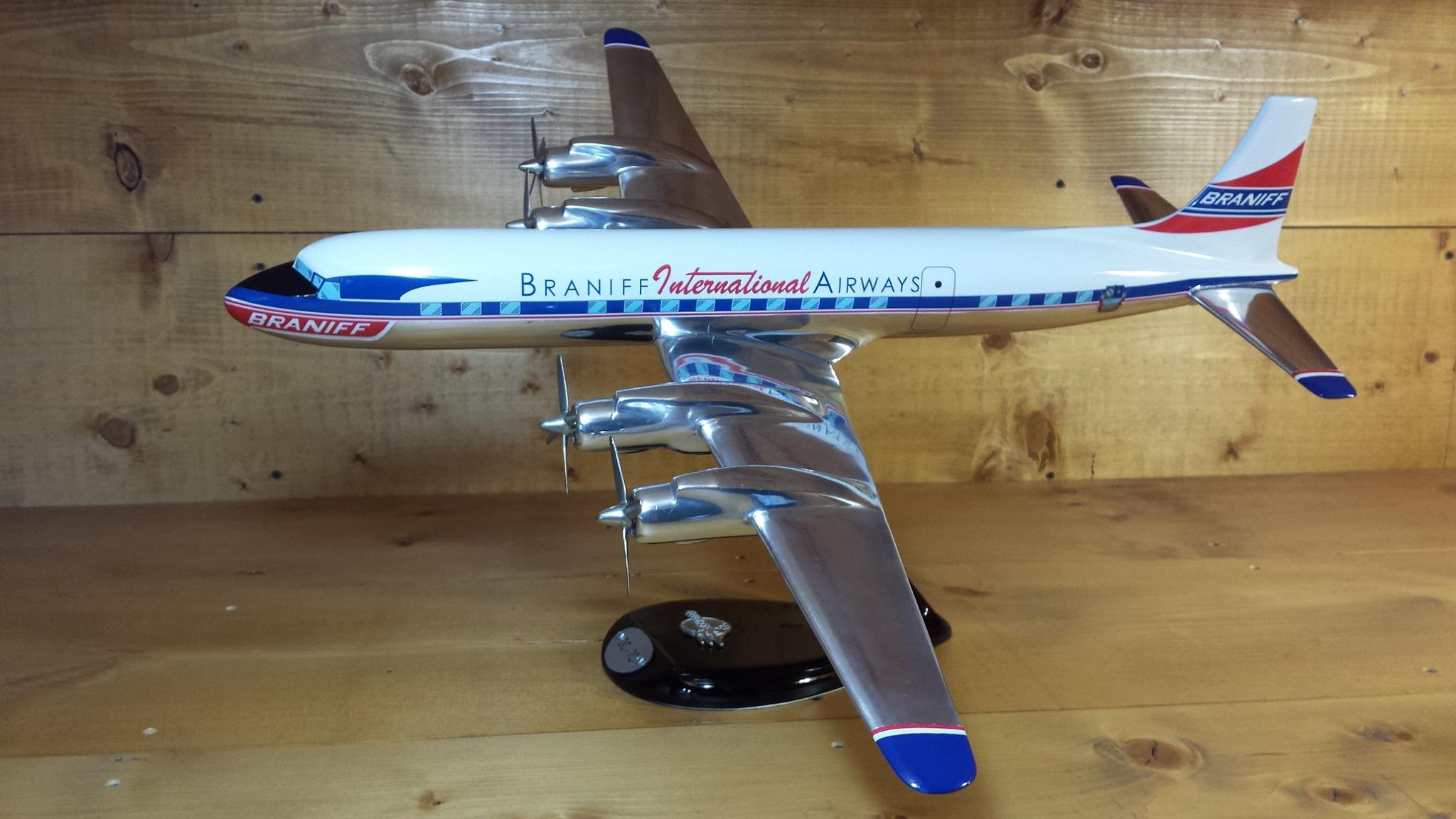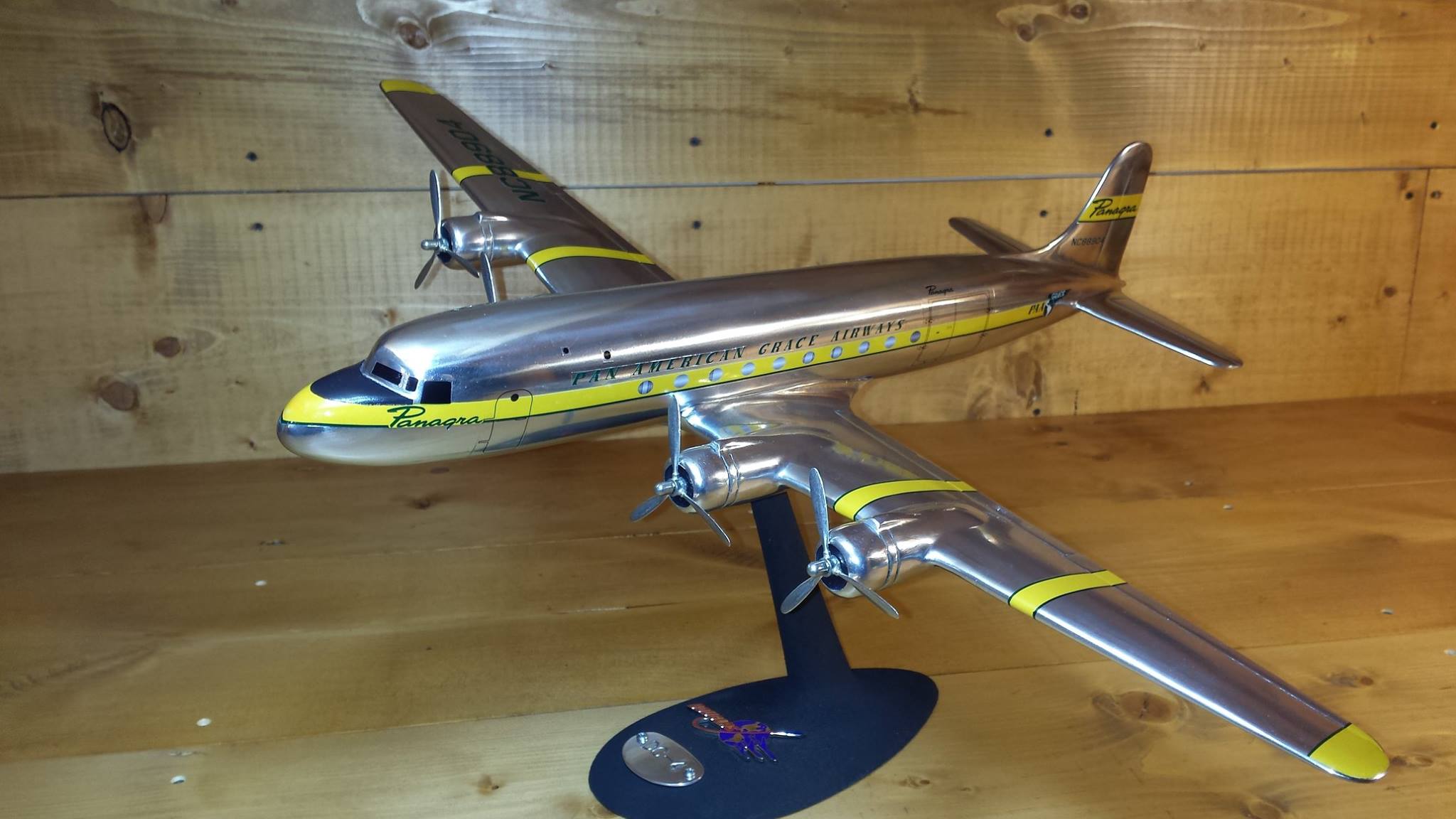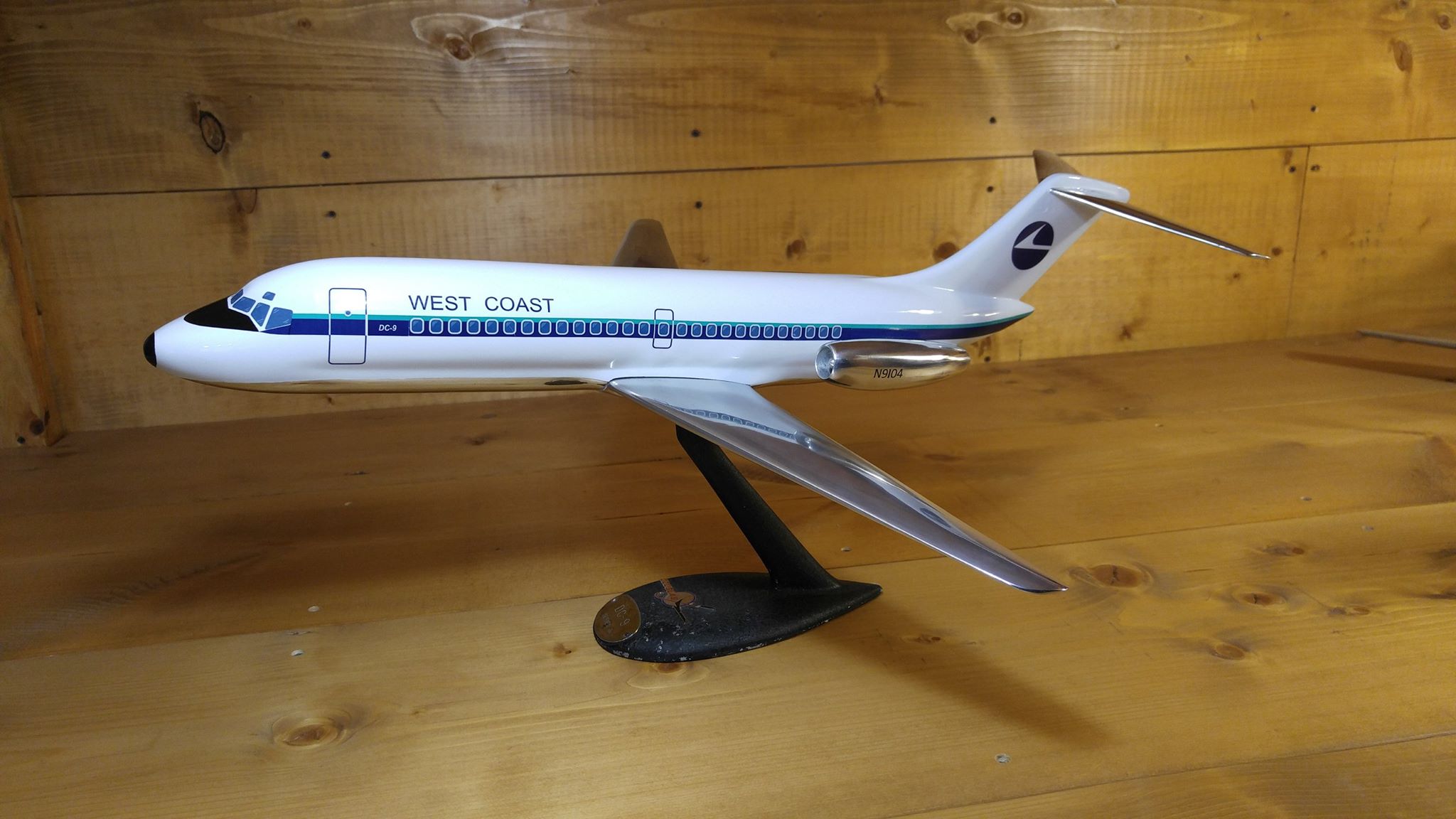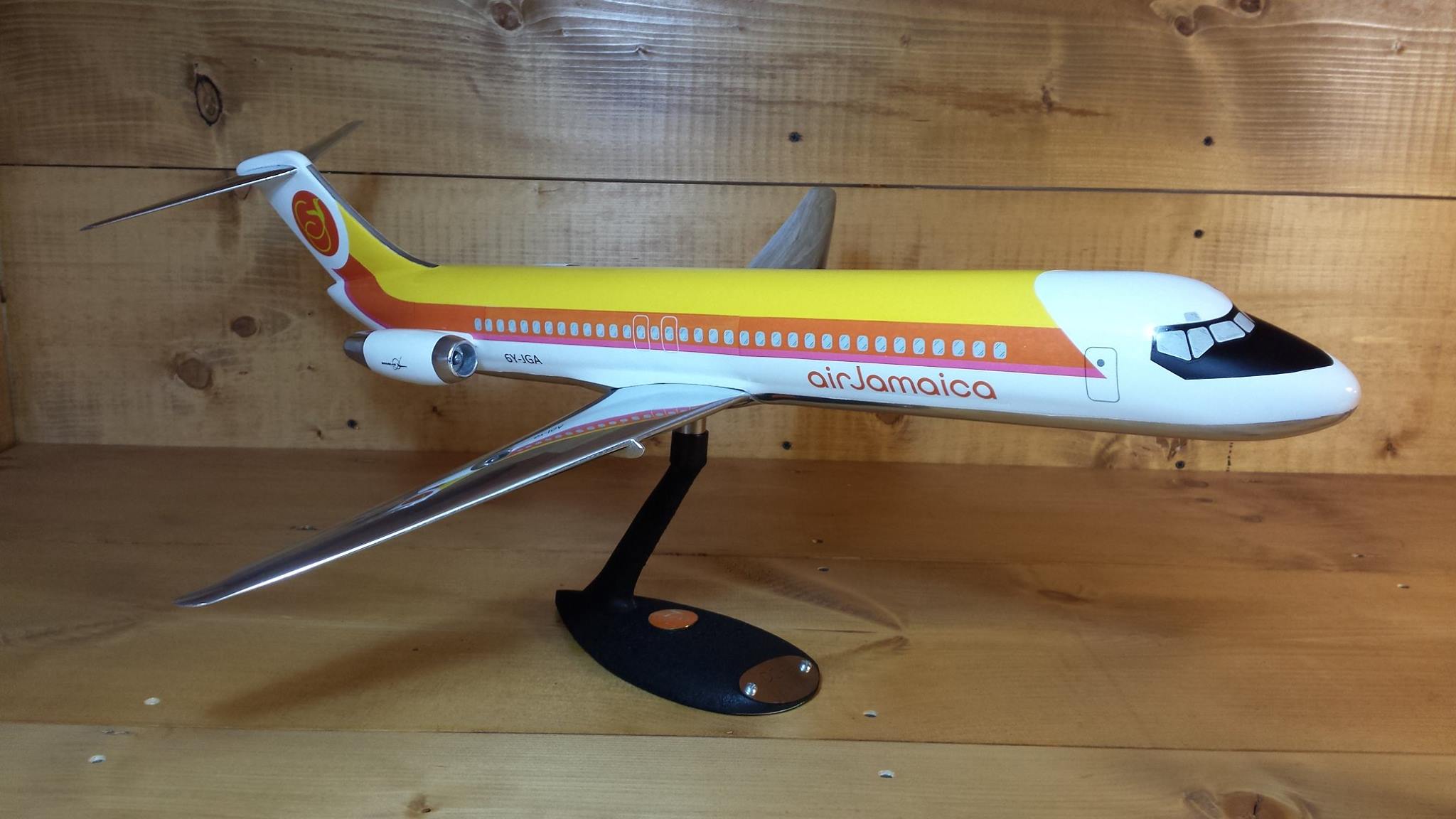
Douglas Factory Models
Written by Jim Striplin
Airline issued models, otherwise known as “Airline Counter Models” or “Travel Agency Models”, have always been source of fascination for Airline enthusiasts. These models were manufactured for the Airlines by many notable model builders going back as far as the 1920s. These models were first made of wood and were later constructed of aluminum and modern plastics.
In this first article, I have decided to feature the models produced for the Airlines by the Douglas Aircraft Corporation, commonly referred to as Douglas Factory Models or DFMs. The Douglas Aircraft Corporation, was of course, one of the greatest Aircraft manufacturers of the 20th Century. Douglas also had the foresight to provide its customers with very high quality models for sales promotion and advertising. Models were given to Airline companies that purchased airplanes from Douglas. Extra models could be purchased by an Airline to be displayed in Airport terminals, Airline ticket offices, and Travel Agencies.
Donald Douglas, Jr., the son of company president Donald Douglas, Sr., is said to have taken an interest in establishing a factory model shop about the time the DC-2 was being developed. A Douglas factory worker, Victor Pastushin, a Russian immigrant, was at the same time already producing ashtray type models on his own. Pastusian is likely to have had some influence on Douglas management, and Donald Douglas, Jr. in starting a factory model shop. (Victor Pastushin will be the subject of a future article on “Airline Ashtray Models”) Donald Douglas, Jr. has always been credited with the establishment of the Douglas Factory Model Shop, which, however, was always kept as a separate entity by Douglas, Jr. from the Douglas Aircraft Corporation itself.
The first Douglas Model Shop has always been believed to be operated in the Douglas Aircraft Santa Monica, California plant. It is unclear, however, if there was an actual Aluminum foundry located on Factory premises. An Aluminum foundry incorporates a furnace to melt Aluminum that is then poured into sand molds. More than likely a foundry located somewhere in the Los Angeles basin, already producing airplane parts for Douglas, did the actual casting. Workers at the model shop would then laboriously file out and hand polish the sandcast models before the applying paint and decals.
The same Zinc Chromate primer, and finish enamel paint used on real Douglas aircraft, were used in finishing the models. Decals were produced using high quality water transfer decal sheet and Airline livery colors were applied using the silk screen process.
It is known that the DC-2, DC-3 and DC-4 models were actual sand castings. Beginning with the DC-6 models, very expensive permanent molds, made of tool steel, were used to cast the models. A sand core was placed inside the fuselage mold to make the model hollow, and lighter. Permanent molds were used to cast all models from the DC-6 to the DC-8-63. Most of the Douglas models were cast in 1/50th scale. This scale was the most common size desired by Airlines and Travel Agencies. 1/72nd models were also produced but were less popular. The early DC-2 models were produced in larger scales. It should be noted that the Douglas factory also produced models of its Military aircraft (C-124s, C-133s, B-66s, etc.).
The Douglas factory produced Aluminum models from 1934 to 1966. After 1966 Douglas models were produced by a company called Marketing Aids located in Anaheim, California. Marketing Aids produced mainly DC-9s, DC-8-63s, and DC-10s in fiberglass and plastics. Marketing Aids inherited a great number of unfinished Aluminum models (blanks) from Douglas, along with a huge inventory of Douglas factory decals. They also had acquired many leftover finished Aluminum models, some of which were sold to private individuals. With the merger of Douglas with McDonnell (forming McDonnell-Douglas) in April of 1967, the era of the Douglas model came to an end. Marketing Aids continued to produce some models for McDonnell-Douglas for a short time. The remaining inventory of Aluminum Douglas model blanks, decal sheets, and fiberglass models were either sold off or simply thrown away.
In conclusion, the models produced by the Douglas factory, and later Marketing Aids, are highly regarded by collectors and Airline historians. Noted for accuracy and correct scale, they are a prized addition to any model airliner collection.
Trackback from your site.







Patrick Jacobson
| #
I have a 1/50 DC-4 DFM missing a stand and props (and most of its paint). Any ideas on where I can get replacement parts?
Reply
Joseph White
| #
I am having my son make me some propellers on his 3-D printer.
Reply
Hank Lam
| #
## Comment SPAM Protection: Shield Security marked this comment as “Pending Moderation”. Reason: Failed AntiBot Verification ##
I have a metal Douglas DC-6? I sort-of restored in the mid 80’s after rescuing it. Particularly interesting is there are round solar cells machined into the wings (4 on each wing) which supply electricity to turn the props (motors). Yes, it now works. Never have I seen another – and it looks like a factory item, not a hack upgrade. Model is in fair condition otherwise.
Reply
pari
| #
i have a DFM dc7 with the same solar cells. the cells are old and worn out. trying to find new cells to replace them.
Reply
ruben baghdassarian
| #
Hi
Can you share some photos of this solar powered model if still in your collection.
Thank you
Ruben
Reply
Steve anderson
| #
I also have a. douglas factory model vintage 1950s c124 globemaster for sale all decals intact usaf all diecast alum matching serial #s on wing /body #267 29 ” wingspan 750.00 obo thanks steve
Reply
ruben baghdassarian
| #
Hi
Do you still have the model? Can you share some photos. Thanks
Reply
ruben baghdassarian
| #
Hi
Is your model still available
Thanks
Reply
doug campbell
| #
I have a factory made model with a light blueish green coating made of cast aluminum in two sections but its a 707—was it made by douglas or boeing or from else where?
Reply
Paul Edward Thomas
| #
I have a Delta factory DC8 1/50 scale model in very good condition and a Lufthansa 1/100 medal travel agency model in 1950s/60s paint no stand
Reply
Daniel Jansen
| #
I’ve have a DC3 in American Airlines livery. I’m told it was a display model that sat in a travel agency’s window in NYC when the DC3 was the flagship! Her number was NC 16001. It’s in less than perfect shape when I bought it. I decided to keep it on the same shape as I have not found any suitable parts or restoration folks. Certainly a skill in making this example!
Reply
Ruben
| #
Can you share some photos.
Thanks
Reply
Blaine henkel
| #
Just acquired some DFM. One is a C-124. It’s 22 inches in length and 30 inches wingspan, all aluminum. I would like to know more about it. Year it was made , value . Who might be interested in buying it. I’ve smaller versions in metal of different models of DC’s Thank you for your time
Reply
ruben
| #
Please drop me a line if you
Have any models to sell.
Thanks
Reply
Ed Das
| #
Thanks for the interesting article. I enjoy collecting the smaller models which I detail on my airplane ashtrays page of my website. A good friend in Toronto makes very nice sand cast aluminum models of aircraft (most military) from the 40’s 50’s and 60’s in case you ever come across any collectors looking for models.
Reply
Bill Moore
| #
Dad was a captain with Philippine Airlines after WWII (ETO, C-47, C-46) and with National Airlines 1951 to 1976. Great time of my life in Miami around all those recips, Electras, B-727s and DC-8s (his last airplane).
Reply
Tim Hartman
| #
Are these Douglas display models available to purchase?
Tim
Reply
Cheryl blackburn
| #
My grandfather, along with 2 ladies, made a model of the Tulsa Douglas Plant during WWII. He too, made ashtrays and models shortly after the war to ‘work off’ his tool check. I have several models to scale and one at the scale that was placed on a swivel on top of the ashtrays he made for the Army Air Corps big shots there.
Reply
Gunnar rostad
| #
Great ..finally someone made an fact based article on these models. What about adding all types og castings Douglas made ……letting readers adding pictures…..
Reply
LARRY RICHARDS
| #
Hello Jim. I have been a member since you all started the annual shows over the last 40 years. I now live in Sparks Nevada. Wanted to let you know that I have here at home a few of the fiberglass/plastic DC-8 models (undecorated/aluminum color) still in their original cardboard boxes from Douglas. I went down to Douglas in Long Beach and bought 6 of the models. I have left a DC-8-63 100 scale / DC-8-61 100 scale and DC-8-55 100 scale. I would love to sell off these trophies as they are in excellent condition but can’t go to the convention to sell.. Any ideas? or would you like to buy them and take them to a convention to get a good price for them? Either way I have them and anyone wanting to buy these you could tell them I have them. Larry Richards / phone: 775-354-2307. Love to talk to you about them if you desire.
Reply
John G Macalla
| #
Being a airline modeler it’s great to see large factory models that once adorned travel agency lobbies. Looking at these makes me wonder what happened to the DC-7D turbine engine metal model that was in the Douglas Museum at Santa Monica years ago?
I always looked forward to the WAHS model section of the journal. I hope this area will be continued in the future.
Reply